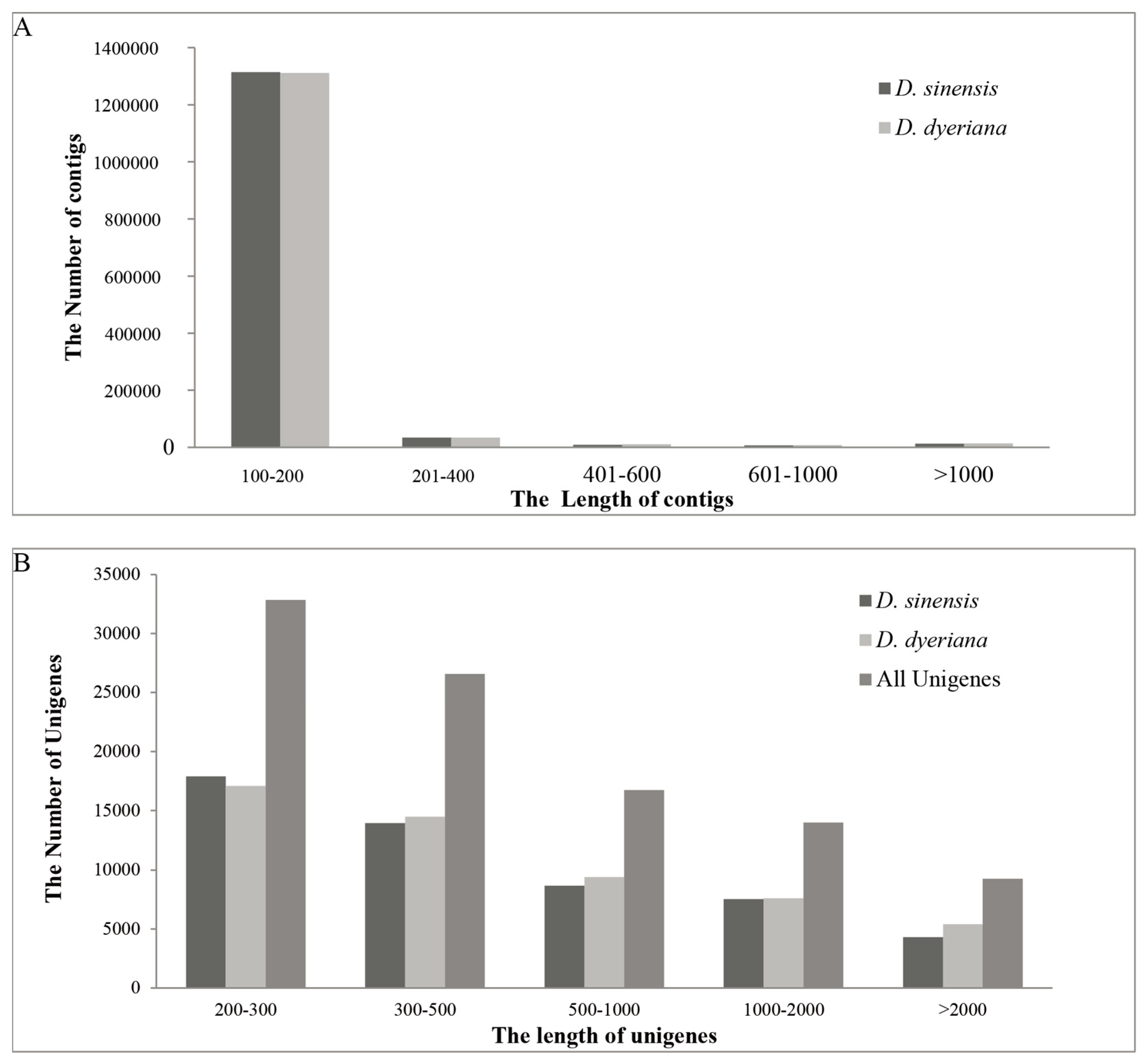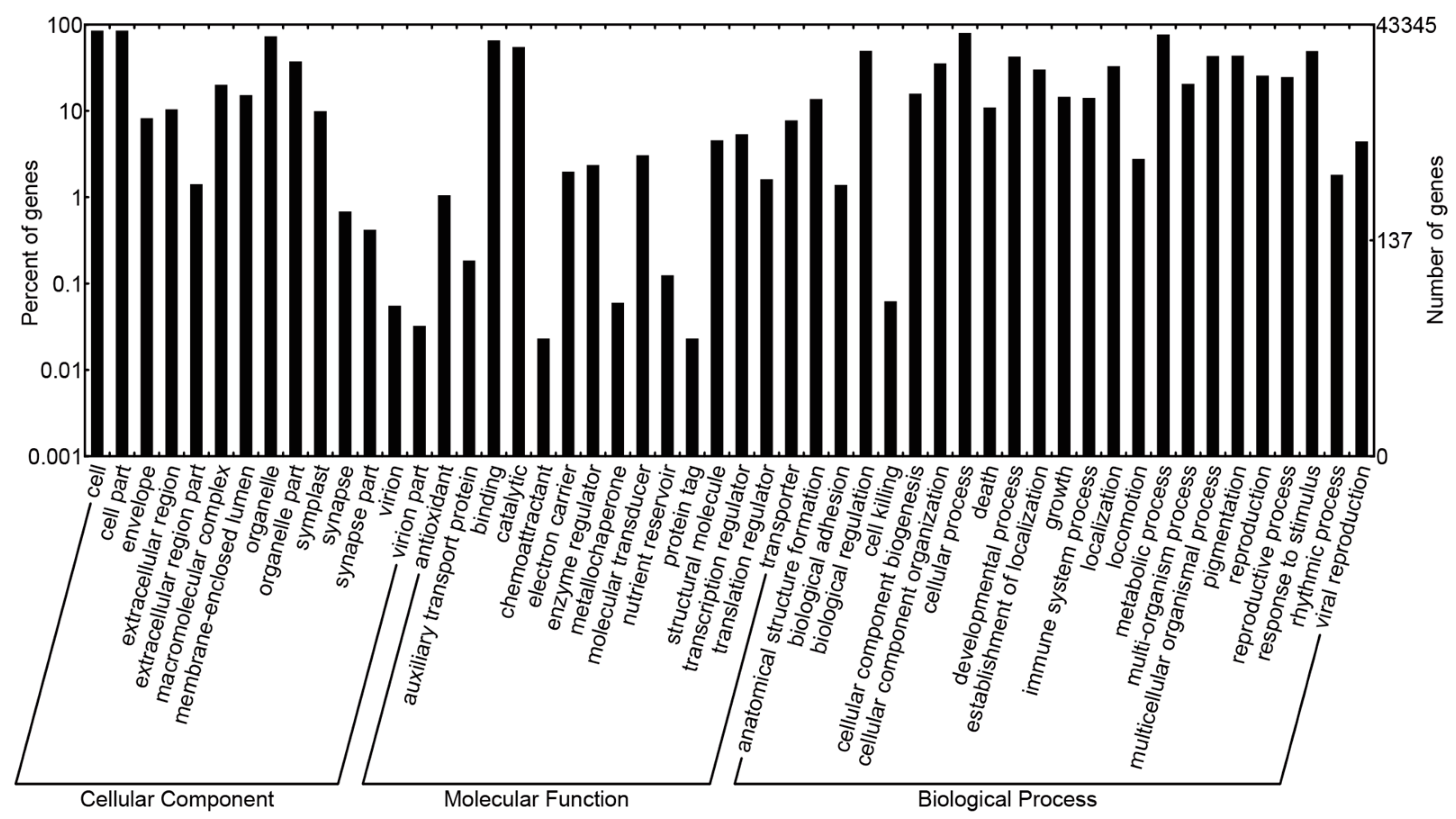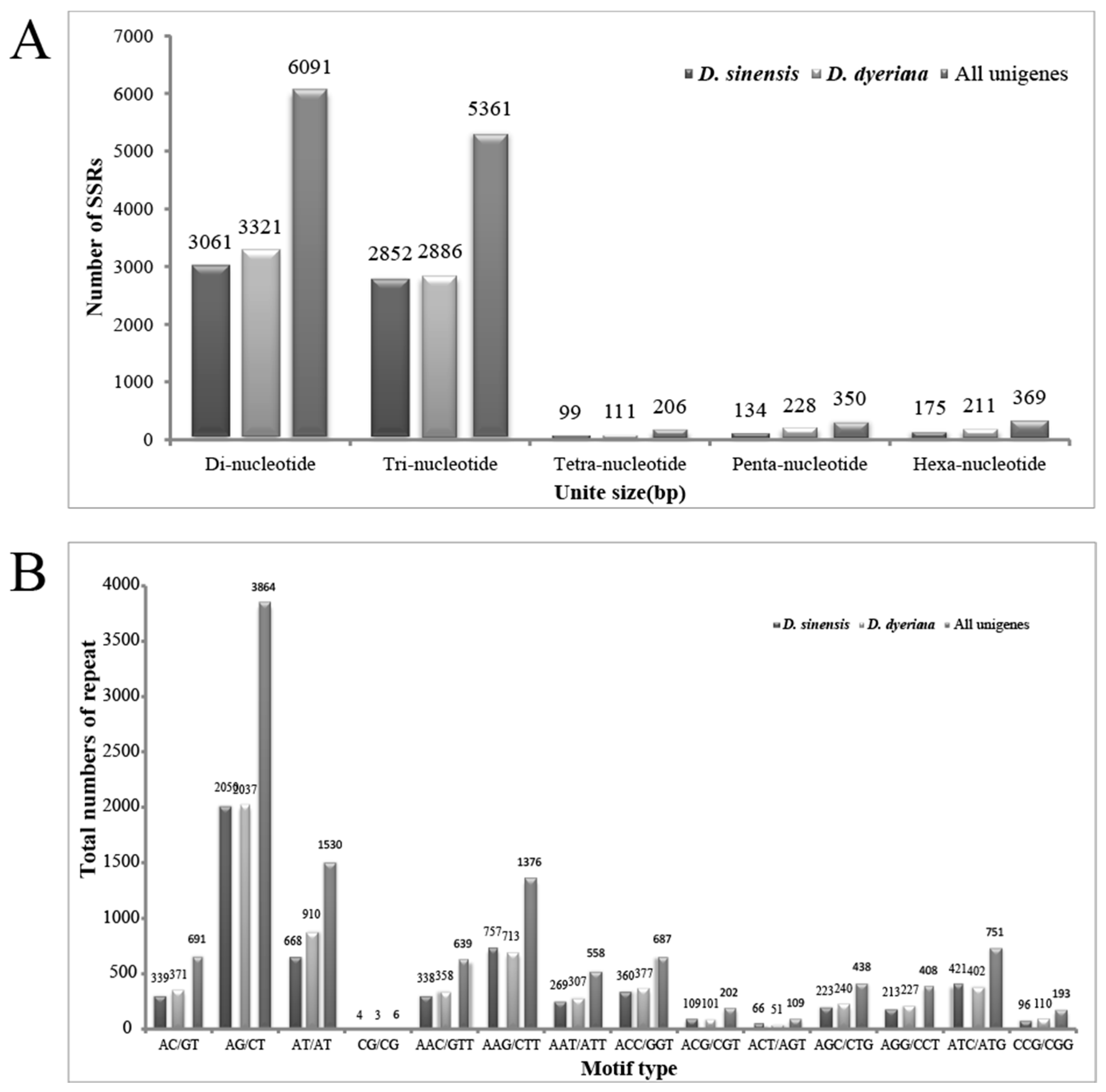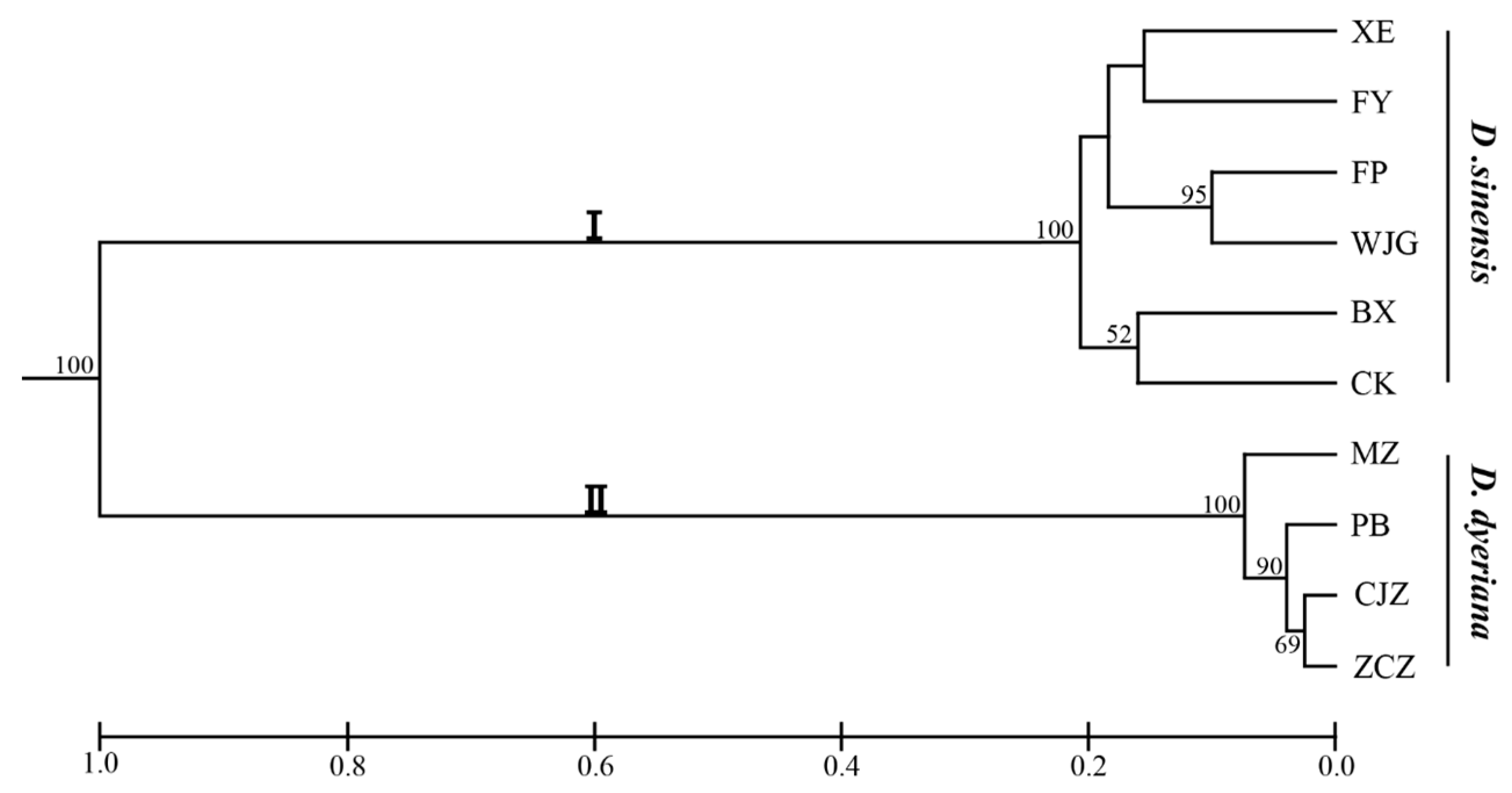Transcriptome Sequencing and Development of Genic SSR Markers of an Endangered Chinese Endemic Genus Dipteronia Oliver (Aceraceae)
Abstract
:1. Introduction
2. Results
2.1. De Novo Assembly of Illumina Sequencing Data

| Species | Total Reads | Total Length of Reads | GC (%) | Q20 (%) | Number of Contigs | Total Length of Contigs |
|---|---|---|---|---|---|---|
| D. sinensis | 40,615,432 | 4,101,851,805 | 45.50 | 88.50 | 1,377,057 | 114,648,897 |
| D. dyeriana | 53,620,610 | 5,314,269,235 | 45.21 | 90.14 | 1,378,610 | 117,846,656 |
| Unigenes Source | Total Number of Unigenes | Total Length of Unigenes | N50 of Unigenes | Mean Length of Unigenes |
|---|---|---|---|---|
| D. sinensis | 52,351 | 39,234,224 | 1351 | 749 |
| D. dyeriana | 53,983 | 43,674,405 | 1519 | 809 |
| All | 99,358 | 77,820,010 | 1452 | 783 |
2.2. Functional Annotation for Non-Redundant Unigene Sequences

2.3. Detection of SSR Loci, Development and Validation of Microsatellite Markers
| Category | D. Sinensis | D. Dyeriana | All Unigenes |
|---|---|---|---|
| Total number of sequences examined | 52,351 | 53,983 | 99,358 |
| Total size of examined sequences (bp) | 39,234,224 | 43,674,405 | 77,820,010 |
| Total number of identified SSRs | 6321 | 6757 | 12,377 |
| Number of SSR containing sequences | 5289 | 5614 | 10,253 |
| Number of sequences containing more than 1 SSR | 813 | 898 | 1658 |
| Number of SSRs present in compound formation a | 29 | 27 | 717 |

2.4. Genetic Diversity Analysis of D. sinensis and D. dyeriana
| Population Code | Number of Individuals | Locations | Coordinates | Species |
|---|---|---|---|---|
| BX | 4 | Baoxing, Sichuan | 30.54°N, 102.71°E | D. sinensis |
| CK | 4 | Chengkou, Chongqing | 32.04°N, 108.72°E | D. sinensis |
| FY | 4 | Fuyan, Guizhou | 27.34°N, 108.05°E | D. sinensis |
| FP | 4 | Foping, Shaanxi | 33.68°N, 107.98°E | D. sinensis |
| WJG | 4 | Wanjiagou, Hubei | 31.40°N, 110.55°E | D. sinensis |
| XE | 4 | Xuan‘en, Hubei | 30.04°N, 109.67°E | D. sinensis |
| MZ | 5 | Mengzi, Yunan | 23.40°N, 103.78°E | D. dyeriana |
| CJZ | 5 | Chenjiazha, Yunan | 23.35°N, 103.97°E | D. dyeriana |
| ZCZ | 5 | Zhongcaozi, Yunan | 23.27°N, 103.45°E | D. dyeriana |
| PB | 5 | Pingbian, Yunan | 23.29°N, 103.88°E | D. dyeriana |

3. Discussion
3.1. Sequences Assembly and Annotation of Dipteronia
3.2. Genic SSR Distribution and Frequency in Dipteronia Transcriptome
3.3. Polymorphic SSR Markers and Diversity Analyses of Dipteronia
4. Experimental Section
4.1. Plant Materials
4.2. RNA Extracting, cDNA Library Construction and Illumina Paired-End Sequencing
4.3. De Novo Assembly, Analysis of Sequences and Functional Annotation
4.4. Microsatellite Screening and Primer Design
4.5. DNA Isolation, PCR Amplification and SSR Validation
4.6. Genetic Diversity Analysis and Microsatellite Scoring
5. Conclusions
Supplementary Materials
Acknowledgments
Author Contributions
Conflicts of Interest
References
- Oliver, D. Dipteronia sinensis. In Hooker's Icones Plantarum; 3rd Series; plate, England; 1889; Volume 9. [Google Scholar]
- Henry, A. Chinese maples. Gard. Chron. 1903, 3, 21–22. [Google Scholar]
- McClain, A.M.; Manchester, S.R. Dipteronia (Sapindaceae) from the Tertiary of North America and implications for the phytogeographic history of the Aceroideae. Am. J. Bot. 2001, 88, 1316–1325. [Google Scholar] [CrossRef] [PubMed]
- Fu, L.K.; Jin, J.M. China Plant Red Data Book-Rare and Endangered Plants; Science Press: Beijing, China, 1992; Volume 1. [Google Scholar]
- Ouyang, Z.Q.; Su, W.H.; Zhang, G.F. Studies on character of seed germination of rare plant Dipteronia dyeriana. Acta Bot. Yunnanica 2005, 28, 509–514. [Google Scholar]
- Li, S.; Cai, Y.L.; Qian, Z.Q.; Zhao, G.F. Researches on the relationship between the morphological and genetic variations of Dipteronia dyeriana Henry (Aceraceae). Acta Ecol. Sin. 2003, 24, 925–931. [Google Scholar]
- Li, S.; Qian, Z.Q.; Cai, Y.L.; Zhao, G.F. A comparison of the genetic diversity in Dipteronia sinensis Oliv and Dipteronia dyeriana Henry. Front. Biol. 2006, 1, 381–388. [Google Scholar] [CrossRef]
- Shi, Y.N.; Zhou, Y.P.; Long, C.L.; Li, M.L.; Wang, Y.H.; Li, X.Y.; Guo, R.; Wang, H.S. Cycloheximide derivatives from the fruits of Dipteronia dyeriana. Helv. Chim. Acta 2009, 92, 1545–1549. [Google Scholar] [CrossRef]
- Yang, J.; Qian, Z.Q.; Liu, Z.L.; Li, S.; Sun, G.L.; Zhao, G.F. Genetic diversity and geographical differentiation of Dipteronia Oliv. (Aceraceae) endemic to China as revealed by AFLP analysis. Biochem. Syst. Ecol. 2007, 35, 593–599. [Google Scholar] [CrossRef]
- Yang, J.; Li, S.; Sun, G.; Yuan, Y.; Zhao, G.F. Population structure and genetic variation in the genus Dipteronia Oliv. (Aceraceae) endemic to China as revealed by cpSSR analysis. Plant Syst. Evol. 2008, 272, 97–106. [Google Scholar] [CrossRef]
- Hao, C.; Zhang, X.Y.; Wang, L.F.; Dong, Y.S.; Shang, X.W.; Jia, J.Z. Genetic diversity and core collection evaluations in common wheat germplasm from the Northwestern Spring Wheat Region in China. Mol. Breed. 2006, 17, 69–77. [Google Scholar] [CrossRef]
- Barkley, N.A.; Roose, M.L.; Krueger, R.R.; Federici, C.T. Assessing genetic diversity and population structure in a Citrus germplasm collection utilizing simple sequence repeat markers (SSRs). Theor. Appl. Genet. 2006, 112, 1519–1531. [Google Scholar] [CrossRef] [PubMed]
- Song, Z.; Xu, X.; Wang, B.; Chen, J.; Lu, B.R. Genetic diversity in the northernmost Oryza rufipogon populations estimated by SSR markers. Theor. Appl. Genet. 2003, 107, 1492–1499. [Google Scholar] [CrossRef] [PubMed]
- Dirlewanger, E.; Cosson, P.; Tavaud, M.; Aranzana, M.; Poizat, C.; Zanetto, A.; Arús, P.; Laigret, F. Development of microsatellite markers in peach [Prunus. persica (L.) Batsch] and their use in genetic diversity analysis in peach and sweet cherry (Prunus avium L.). Theor. Appl. Genet. 2002, 105, 127–138. [Google Scholar] [PubMed]
- Ali, M.; Rajewski, J.; Baenziger, P.; Gill, K.; Eskridge, K.; Dweikat, I. Assessment of genetic diversity and relationship among a collection of US sweet sorghum germplasm by SSR markers. Mol. Breed. 2008, 21, 497–509. [Google Scholar] [CrossRef]
- Bucci, G.; Anzidei, M.; Madaghiele, A.; Vendramin, G. Detection of haplotypic variation and natural hybridization in halepensis-complex pine species using chloroplast simple sequence repeat (SSR) markers. Mol. Ecol. 1998, 7, 1633–1643. [Google Scholar] [CrossRef]
- Karanth, K.P.; Avivi, A.; Beharav, A.; Nevo, E. Microsatellite diversity in populations of blind subterranean mole rats (Spalax ehrenbergi superspecies) in Israel: Speciation and Adaptation. Biol. J. Linn. Soc. 2004, 83, 229–241. [Google Scholar] [CrossRef]
- Song, Z.; Zhu, W.; Rong, J.; Xu, X.; Chen, J.; Lu, B.R. Evidences of introgression from cultivated rice to Oryza rufipogon (Poaceae) populations based on SSR fingerprinting: Implications for Wild Rice Differentiation and Conservation. Evol. Ecol. 2006, 20, 501–522. [Google Scholar] [CrossRef]
- Izzah, N.K.; Lee, J.; Jayakodi, M.; Perumal, S.; Jin, M.; Park, B.S.; Ahn, K.; Yang, T.J. Transcriptome sequencing of two parental lines of cabbage (Brassica oleracea L. var. capitata L.) and construction of an EST-based genetic map. BMC Genom. 2014, 15. [Google Scholar] [CrossRef] [PubMed]
- Su, H.L.; Li, Z.H.; Zhao, P.; Bai, G.Q.; Zhou, T.H.; Liu, Z.L.; Zhao, G.F. Isolation and characterization of polymorphic microsatellite loci in the endangered plant Dipteronia sinensis (Sapindaceae). Am. J. Bot. 2012, 99, e425–e427. [Google Scholar] [CrossRef] [PubMed]
- Chen, C.; Ren, B.B.; Xu, X.H.; Fu, C.X.; Qiu, Y.X. Isolation and characterization of microsatellite markers for Dipteronia dyerana (Sapindaceae), an endangered endemic species in China. Am. J. Bot. 2011, 98, e271–e273. [Google Scholar] [CrossRef] [PubMed]
- Rai, H.S.; Mock, K.E.; Richardson, B.A.; Cronn, R.C.; Hayden, K.J.; Wright, J.W.; Knaus, B.J.; Wolf, P.G. Transcriptome characterization and detection of gene expression differences in aspen (Populus tremuloides). Tree Genet. Genomes 2013, 9, 1031–1041. [Google Scholar] [CrossRef]
- Pedroni, M.; Sondgeroth, K.; Gallego-Lopez, G.; Echaide, I.; Lau, A. Comparative transcriptome analysis of geographically distinct virulent and attenuated Babesia bovis strains reveals similar gene expression changes through attenuation. BMC Genom. 2013, 14. [Google Scholar] [CrossRef] [PubMed]
- Yoo, M.J.; Wendel, J.F. Comparative evolutionary and developmental dynamics of the cotton (Gossypium hirsutum) fiber transcriptome. PLoS Genet. 2014, 10, e1004073. [Google Scholar] [CrossRef] [PubMed]
- Ma, H.Y.; Jiang, W.; Liu, P.; Feng, N.N.; Ma, Q.Q.; Ma, C.Y.; Li, S.J.; Liu, Y.X.; Qiao, Z.G.; Ma, L.B. Identification of transcriptome-derived microsatellite markers and their association with the growth performance of the mud crab (Scylla paramamosain). PLoS ONE 2014, 9, e89134. [Google Scholar] [CrossRef] [PubMed]
- Silva, P.I.; Martins, A.M.; Gouvea, E.G.; Pessoa-Filho, M.; Ferreira, M.E. Development and validation of microsatellite markers for Brachiaria ruziziensis obtained by partial genome assembly of Illumina single-end reads. BMC Genom. 2013, 14. [Google Scholar] [CrossRef] [PubMed]
- Agarwal, G.; Jhanwar, S.; Priya, P.; Singh, V.K.; Saxena, M.S.; Parida, S.K.; Garg, R.; Tyagi, A.K.; Jain, M. Comparative analysis of kabuli chickpea transcriptome with desi and wild chickpea provides a rich resource for development of functional markers. PLoS ONE 2012, 7, e52443. [Google Scholar]
- Wang, C.H.; Liu, X.J.; Peng, S.T.; Xu, Q.; Yuan, X.P.; Feng, Y.; Yu, H.Y.; Wang, Y.P.; Wei, X.H. Development of novel microsatellite markers for the BBCC Oryza genome (Poaceae) using high-throughput sequencing technology. PLoS ONE 2014, 9, e91826. [Google Scholar] [CrossRef] [PubMed]
- Li, D.J.; Deng, Z.; Qin, B.; Liu, X.H.; Men, Z.H. De novo assembly and characterization of bark transcriptome using Illumina sequencing and development of EST-SSR markers in rubber tree (Hevea brasiliensis Muell. Arg.). BMC Genom. 2012, 13. [Google Scholar] [CrossRef]
- Zheng, X.F.; Pan, C.; Diao, Y.; You, Y.N.; Yang, C.Z.; Hu, Z.L. Development of microsatellite markers by transcriptome sequencing in two species of Amorphophallus (Araceae). BMC Genom. 2013, 14. [Google Scholar] [CrossRef]
- Wang, Z.; Yu, G.H.; Shi, B.B.; Wang, X.M.; Qiang, H.P.; Gao, H.W. Development and characterization of simple sequence repeat (SSR) markers based on RNA-Sequencing of Medicago Sativa and in silico mapping onto the M. truncatula genome. PLoS ONE 2014, 9, e92029. [Google Scholar]
- Guo, R.; Mao, Y.R.; Cai, J.R.; Wang, J.Y.; Wu, J.; Qiu, Y.X. Characterization and cross-species transferability of EST–SSR markers developed from the transcriptome of Dysosma versipellis (Berberidaceae) and their application to population genetic studies. Mol. Breed. 2014, 34, 1733–1746. [Google Scholar] [CrossRef]
- You, Y.N.; Liu, D.C.; Liu, H.B.; Zheng, X.F.; Diao, Y.; Huang, X.F.; Hu, Z.L. Development and characterisation of EST-SSR markers by transcriptome sequencing in taro (Colocasia esculenta (L.) Schoot). Mol. Breed. 2015, 35. [Google Scholar] [CrossRef]
- Duan, C.X.; Li, D.D.; Sun, S.L.; Wang, X.M.; Zhu, Z.D. Rapid development of microsatellite markers for Callosobruchus chinensis using Illumina paired-end sequencing. PLoS ONE 2014, 9, e95458. [Google Scholar] [CrossRef] [PubMed]
- Ai, B.; Gao, Y.; Zhang, X.; Tao, J.J.; Kang, M.; Huang, H.W. Comparative transcriptome resources of eleven Primulina Species, a group of “stone plants” from a biodiversity hot spot. Mol. Ecol. Resour. 2014, 15, 619–632. [Google Scholar] [CrossRef] [PubMed]
- Zalapa, J.E.; Cuevas, H.; Zhu, H.; Steffan, S.; Senalik, D.; Zeldin, E.; McCown, B.; Harbut, R.; Simon, P. Using next-generation sequencing approaches to isolate simple sequence repeat (SSR) loci in the plant sciences. Am. J. Bot. 2012, 99, 193–208. [Google Scholar] [CrossRef] [PubMed]
- Varshney, R.K.; Graner, A.; Sorrells, M.E. Genic microsatellite markers in plants: Features and Applications. TRENDS Biotechnol. 2005, 23, 48–55. [Google Scholar] [CrossRef] [PubMed]
- Wang, S.F.; Wang, X.F.; He, Q.W.; Liu, X.X.; Xu, W.L.; Li, L.B.; Gao, J.W.; Wang, F.D. Transcriptome analysis of the roots at early and late seedling stages using Illumina paired-end sequencing and development of EST-SSR markers in radish. Plant. Cell Rep. 2012, 31, 1437–1447. [Google Scholar] [CrossRef] [PubMed]
- Zhang, W.W.; Tian, D.K.; Huang, X.; Xu, Y.X.; Mo, H.B.; Liu, Y.B.; Meng, J.; Zhang, D.S. Characterization of flower-bud transcriptome and development of genic SSR Markers in Asian Lotus (Nelumbo nucifera Gaertn.). PLoS ONE 2014, 9, e112223. [Google Scholar] [CrossRef] [PubMed]
- Guo, R.; Luo, M.; Long, C.L.; Li, M.L.; Ouyang, Z.Q.; Zhou, Y.P.; Wang, Y.H.; Li, X.Y.; Shi, Y.N. Triterpenoid ester saponins from Dipteronia dyeriana. Helv. Chim. Acta 2008, 91, 1728–1735. [Google Scholar] [CrossRef]
- Shi, Y.N.; Wang, Y.P.; Guo, R.; Zhang, J.Y.; Wang, Y.Z.; Jin, H.; Long, C.L. Chemical constituents from the fruits of Dipteronia sinensis Oliv. J. Yunnan Agric. Univ. 2012, 4, 600–603. [Google Scholar]
- Li, X.B.; Jin, F.; Jin, L.; Jackson, A.; Huang, C.; Li, K.H.; Shu, X.L. Development of Cymbidium ensifolium genic-SSR markers and their utility in genetic diversity and population structure analysis in Cymbidiums. BMC Genet. 2014, 15. [Google Scholar] [CrossRef] [PubMed]
- Zhai, L.L.; Xu, L.; Wang, Y.; Cheng, H.; Chen, Y.L.; Gong, Y.Q.; Liu, L.W. Novel and useful genic-SSR markers from de novo transcriptome sequencing of radish (Raphanus sativus L.). Mol. Breed. 2014, 33, 611–624. [Google Scholar] [CrossRef]
- Dutta, S.; Kumawat, G.; Singh, B.P.; Gupta, D.K.; Singh, S.; Dogra, V.; Gaikwad, K.; Sharma, T.R.; Raje, R.S.; Bandhopadhya, T.K.; et al. Development of genic-SSR markers by deep transcriptome sequencing in pigeonpea (Cajanus cajan (L.) Millspaugh). BMC Plant Biol. 2011, 11. [Google Scholar] [CrossRef] [PubMed]
- Fu, N.; Wang, Q.; Shen, H.-L. De novo assembly, gene annotation and marker development using Illumina paired-end transcriptome sequences in celery (Apium graveolens L.). PLoS ONE 2013, 8, e57686. [Google Scholar]
- Blanca, J.; Cañizares, J.; Roig, C.; Ziarsolo, P.; Nuez, F.; Picó, B. Transcriptome characterization and high throughput SSRs and SNPs discovery in Cucurbita pepo (Cucurbitaceae). BMC Genom. 2011, 12. [Google Scholar] [CrossRef] [PubMed]
- Aggarwal, R.K.; Hendre, P.S.; Varshney, R.K.; Bhat, P.R.; Krishnakumar, V.; Singh, L. Identification, characterization and utilization of EST-derived genic microsatellite markers for genome analyses of coffee and related species. Theor. Appl. Genet. 2007, 114, 359–372. [Google Scholar] [CrossRef] [PubMed]
- Jhanwar, S.; Priya, P.; Garg, R.; Parida, S.K.; Tyagi, A.K.; Jain, M. Transcriptome sequencing of wild chickpea as a rich resource for marker development. Plant Biotechnol. J. 2012, 10, 690–702. [Google Scholar] [CrossRef] [PubMed]
- Cardle, L.; Ramsay, L.; Milbourne, D.; Macaulay, M.; Marshall, D.; Waugh, R. Computational and experimental characterization of physically clustered simple sequence repeats in plants. Genetics 2000, 156, 847–854. [Google Scholar] [PubMed]
- Du, Q.Z.; Gong, C.R.; Pan, W.; Zhang, D.Q. Development and application of microsatellites in candidate genes related to wood properties in the Chinese white poplar (Populus tomentosa Carr.). DNA Res. 2013, 20, 31–44. [Google Scholar] [CrossRef] [PubMed]
- Zhang, H.Y.; Wei, L.B.; Miao, H.M.; Zhang, T.D.; Wang, C.Y. Development and validation of genic-SSR markers in sesame by RNA-seq. BMC Genom. 2012, 13. [Google Scholar] [CrossRef] [PubMed]
- Wei, W.L.; Qi, X.Q.; Wang, L.H.; Zhang, Y.X.; Hua, W.; Li, D.H.; Lv, H.X.; Zhang, X.R. Characterization of the sesame (Sesamum indicum L.) global transcriptome using Illumina paired-end sequencing and development of EST-SSR markers. BMC Genom. 2011, 12. [Google Scholar] [CrossRef] [PubMed]
- Zhang, J.N.; Liang, S.; Duan, J.L.; Wang, J.; Chen, S.L.; Cheng, Z.S.; Zhang, Q.; Liang, X.Q.; Li, Y.R. De novo assembly and characterisation of the transcriptome during seed development, and generation of genic-SSR markers in Peanut (Arachis hypogaea L.). BMC Genom. 2012, 13. [Google Scholar] [CrossRef] [PubMed]
- Triwitayakorn, K.; Chatkulkawin, P.; Kanjanawattanawong, S.; Sraphet, S.; Yoocha, T.; Sangsrakru, D.; Chanprasert, J.; Ngamphiw, C.; Jomchai, N.; Therawattanasuk, K. Transcriptome sequencing of Hevea brasiliensis for development of microsatellite markers and construction of a genetic linkage map. DNA Res. 2011, 18, 471–482. [Google Scholar] [CrossRef] [PubMed]
- Jung, S.; Abbott, A.; Jesudurai, C.; Tomkins, J.; Main, D. Frequency, type, distribution and annotation of simple sequence repeats in Rosaceae ESTs. Funct. Integr. Genomic. 2005, 5, 136–143. [Google Scholar] [CrossRef] [PubMed]
- Gao, L.; Tang, J.; Li, H.; Jia, J. Analysis of microsatellites in major crops assessed by computational and experimental approaches. Mol. Breed. 2003, 12, 245–261. [Google Scholar] [CrossRef]
- Yue, X.Y.; Liu, G.Q.; Zong, Y.; Teng, Y.W.; Cai, D.Y. Development of genic SSR markers from transcriptome sequencing of pear buds. J. Zhejiang Univ. Sci. B 2014, 15, 303–312. [Google Scholar] [CrossRef] [PubMed]
- Nicot, N.; Chiquet, V.; Gandon, B.; Amilhat, L.; Legeai, F.; Leroy, P.; Bernard, M.; Sourdille, P. Study of simple sequence repeat (SSR) markers from wheat expressed sequence tags (ESTs). Theor. Appl. Genet. 2004, 109, 800–805. [Google Scholar] [CrossRef] [PubMed]
- Huang, D.N.; Zhang, Y.Q.; Jin, M.D.; Li, H.; Song, Z.; Wang, Y.G.; Chen, J. Characterization and high cross-species transferability of microsatellite markers from the floral transcriptome of Aspidistra saxicola (Asparagaceae). Mol. Ecol. Resour. 2014, 14, 569–577. [Google Scholar] [CrossRef] [PubMed]
- Kaur, S.; Cogan, N.; Pembleton, L.; Shinozuka, M.; Savin, K.; Materne, M.; Forster, J. Transcriptome sequencing of lentil based on second-generation technology permits large-scale unigene assembly and SSR marker discovery. BMC Genom. 2011, 12. [Google Scholar] [CrossRef] [PubMed]
- Wei, L.; Li, S.H.; Liu, S.Q.; He, A.N.; Wang, D.; Wang, J.; Tang, Y.L.; Wu, X.J. Transcriptome analysis of Houttuynia cordata Thunb. by Illumina paired-end RNA sequencing and SSR marker discovery. PLoS ONE 2014, 9, e84105. [Google Scholar] [CrossRef] [PubMed]
- Yadav, H.K.; Ranjan, A.; Asif, M.H.; Mantri, S.; Sawant, S.V.; Tuli, R. EST-derived SSR markers in Jatropha curcas L.: Development, Characterization, Polymorphism, and Transferability across the Species/Genera. Tree Genet. Genomes 2011, 7, 207–219. [Google Scholar] [CrossRef]
- Grabherr, M.G.; Haas, B.J.; Yassour, M.; Levin, J.Z.; Thompson, D.A.; Amit, I.; Adiconis, X.; Fan, L.; Raychowdhury, R.; Zeng, Q.; et al. Full-length transcriptome assembly from RNA-Seq data without a reference genome. Nat. Biotechnol. 2011, 29, 644–652. [Google Scholar] [CrossRef] [PubMed]
- Pertea, G.; Huang, X.; Liang, F.; Antonescu, V.; Sultana, R.; Karamycheva, S.; Lee, Y.; White, J.; Cheung, F.; Parvizi, B.; et al. TIGR Gene Indices clustering tools (TGICL): A Software System for Fast Clustering of Large EST Datasets. Bioinformatics 2003, 19, 651–652. [Google Scholar] [CrossRef] [PubMed]
- Li, W.; Godzik, A. Cd-hit: A Fast Program for Clustering and Comparing Large Sets of Protein or Nucleotide Sequences. Bioinformatics 2006, 22, 1658–1659. [Google Scholar] [CrossRef] [PubMed]
- Conesa, A.; Götz, S.; García-Gómez, J.M.; Terol, J.; Talón, M.; Robles, M. Blast2GO: A Universal Tool for Annotation, Visualization and Analysis in Functional Genomics Research. Bioinformatics 2005, 21, 3674–3676. [Google Scholar] [CrossRef] [PubMed]
- Ashburner, M.; Ball, C.A.; Blake, J.A.; Botstein, D.; Butler, H.; Cherry, J.M.; Davis, A.P.; Dolinski, K.; Dwight, S.S.; Eppig, J.T.; et al. Gene Ontology: Tool for the Unification of Biology. Nat. Genet. 2000, 25, 25–29. [Google Scholar] [CrossRef] [PubMed]
- Ye, J.; Fang, L.; Zheng, H.K.; Zhang, Y.; Chen, J.; Zhang, Z.J.; Wang, J.; Li, S.T.; Li, R.Q.; Bolund, L.; et al. WEGO: A Web Tool for Plotting GO Annotations. Nucleic Acids Res. 2006, 34, W293–W297. [Google Scholar] [CrossRef] [PubMed]
- Kanehisa, M.; Goto, S. KEGG: Kyoto encyclopedia of genes and genomes. Nucleic Acids Res. 2000, 28, 27–30. [Google Scholar] [CrossRef] [PubMed]
- Thiel, T.; Michalek, W.; Varshney, R.; Graner, A. Exploiting EST databases for the development and characterization of gene-derived SSR-markers in barley (Hordeum vulgare L.). Theor. Appl. Genet. 2003, 106, 411–422. [Google Scholar] [PubMed]
- Rozen, S.; Skaletsky, H. Primer3 on the WWW for General Users and for Biologist Programmers. In Bioinformatics Methods and Protocols; Springer: Berlin, Germany, 1999; pp. 365–386. [Google Scholar]
- Peakall, R.; Smouse, P.E. GenAlEx 6.5: Genetic Analysis in Excel. Population genetic software for teaching and research—An update. Bioinformatics 2012, 28, 2537–2539. [Google Scholar] [CrossRef] [PubMed]
- Kalinowski, S.T.; Taper, M.L.; Marshall, T.C. Revising how the computer program CERVUS accommodates genotyping error increases success in paternity assignment. Mol. Ecol. 2007, 16, 1099–1106. [Google Scholar] [CrossRef] [PubMed]
- Miller, M.P. Tools for population genetic analyses (TFPGA) 1.3: A Windows Program for the Analysis of Allozyme and Molecular Population Genetic Data. Available online: http://www.marksgeneticsoftware.net/tfpga.htm (accessed on 13 September 2015).
- Sample Availability: All samples are available from the authors.
© 2016 by the authors. Licensee MDPI, Basel, Switzerland. This article is an open access article distributed under the terms and conditions of the Creative Commons by Attribution (CC-BY) license ( http://creativecommons.org/licenses/by/4.0/).
Share and Cite
Zhou, T.; Li, Z.-H.; Bai, G.-Q.; Feng, L.; Chen, C.; Wei, Y.; Chang, Y.-X.; Zhao, G.-F. Transcriptome Sequencing and Development of Genic SSR Markers of an Endangered Chinese Endemic Genus Dipteronia Oliver (Aceraceae). Molecules 2016, 21, 166. https://doi.org/10.3390/molecules21030166
Zhou T, Li Z-H, Bai G-Q, Feng L, Chen C, Wei Y, Chang Y-X, Zhao G-F. Transcriptome Sequencing and Development of Genic SSR Markers of an Endangered Chinese Endemic Genus Dipteronia Oliver (Aceraceae). Molecules. 2016; 21(3):166. https://doi.org/10.3390/molecules21030166
Chicago/Turabian StyleZhou, Tao, Zhong-Hu Li, Guo-Qing Bai, Li Feng, Chen Chen, Yue Wei, Yong-Xia Chang, and Gui-Fang Zhao. 2016. "Transcriptome Sequencing and Development of Genic SSR Markers of an Endangered Chinese Endemic Genus Dipteronia Oliver (Aceraceae)" Molecules 21, no. 3: 166. https://doi.org/10.3390/molecules21030166
APA StyleZhou, T., Li, Z.-H., Bai, G.-Q., Feng, L., Chen, C., Wei, Y., Chang, Y.-X., & Zhao, G.-F. (2016). Transcriptome Sequencing and Development of Genic SSR Markers of an Endangered Chinese Endemic Genus Dipteronia Oliver (Aceraceae). Molecules, 21(3), 166. https://doi.org/10.3390/molecules21030166





